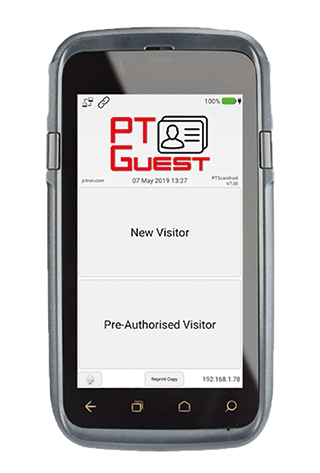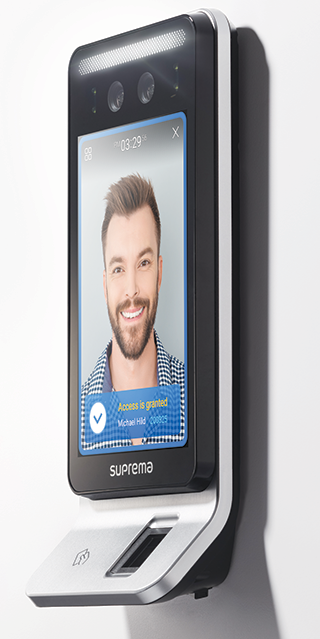

Visitor management (VM) is a critical part of estate security and over the years we have seen the migration from visitor books to more advanced technologies, such as biometrics, licence scanners, LPR and CCTV to support the VM function. Today, however, VM does more than simply manage entry and exit at the gate.
In addition, the advances in technology make it possible to create an integrated platform today that not only incorporates VM, but the estate’s other security systems and even operational systems. The ideal is to have a solution that enables the efficient and fast management of all estate business, integrated into a single interface including access, video, perimeter, alarms, utilities and more. And, of course, with POPIA (finally) happening in July 2021, all of this data needs to be secure, ensuring privacy while being available when needed.
Hi-Tech Security Solutions asked a number of industry specialists for their insight into the progress they have made in integrated VM. Our respondents are:
• Nathan Bearman, co-founder and director, EvTrack.
• Ariel Flax, director, ATG Digital.
• Vanchanzo Peters, product specialist, Powell Tronics.
• Mpho Radiokana, sales manager, neaMetrics.
• Brett Wray, sales consultant, Entry Pro.
Hi-Tech Security Solutions: Are estates focused on integrating various functions into their access and visitor management systems, or are these still primarily standalone functions?
Bearman: There is a move to the automation of access control, where visitors are either pre-registered before arriving at the site or where the host has to electronically approve the visitor when they are at the entrance.
Flax: Most definitely. There’s a lot more to access control and visitor management than just scanning a driver’s licence or recording their details. Most estates are focused on different functionality included in the access and visitor management process; things like SOS alerts, visitor/contractor invitations, visitor reports, etc.

Peters: Yes, estates are extremely interested in integrating various functions as it gives them improved control over visitors and their movements and whereabouts on the premises. It also enhances the visitors’ experience at the entrance to the estates and gives the security guard a real tool in terms of dealing with unexpected visitors. Some examples of the benefits of an integrated system include:
• Pre-defined access to destination eliminating visitors from accessing unauthorised areas.
• Pre-authorisation of visitors via an iOS, Android, web or SMS interface.
• Issue visitors with a single entry and exit PIN code, RFID tag or biometric access.
• Destination and type of visitor reporting.
• Capturing and decoding of licence disc and driver’s licence details directly in to the integrated solution.
• Notifications to residents that their guests have arrived and exited the premises.
• Caters for long stay visitors, blacklisting ID numbers and much more.
Radiokana: Estates are increasingly seeking an integrated and unified solution for the management of their estates, be it for integration with visitor management or other systems, although there are those who might not opt for an integrated solution purely because they are unaware that integration is possible and are not knowledgeable of what can be achieved through integration. They may even anticipate the costs to be higher than what they are.
For estate managers, integrating visitor management means they can assure residents smooth processing of their visitor bookings and often that they will be able to capitalise on using one access control platform for both residents and visitors instead of multiple terminals at entrance points for the same purpose.
Integrating visitor management with access control can provide estate management with a detailed outlook on what is happening in their estates at any given time. This can range from discovering patterns such as what time during the day the estate usually has the highest number of visitors, how long visitors usually spend on average in the estate, and similar information, which also provides estate management with a head start in proactively ensuring that their estate is adequately prepared for any eventualities from a security perspective.
Standalone visitor management is great when used efficiently, but these demand dedicated management and monitoring, taking away time from security and estate management personnel to manage more than one system as compared to managing one integrated system, saving time and effort spent on two systems.
Wray: We find that our clients are diverse in their requirements, with some looking for the simple standalone functions and some looking to get the most out of the system. Most products available rely on third-party integrations due to their lack of expertise and technical in-house resources and capabilities on their own platform (for example, LPR, visitor management, domestic workers, contractors, takeaways, residents etc.). Entry Pro offers additional features and capabilities on our system without any third-party integration requirement as well as reporting and analytical data capabilities crucial to our clients.

Hi-Tech Security Solutions: More VM and access control systems are being hosted in the cloud, why do estates choose this option and do the solutions on offer protect them from potential POPIA complaints?
Bearman: Cloud-based systems remove the requirement for an onsite server that could be stolen, vandalised or damaged during load shedding. POPIA requirements would be the same for a cloud-hosted system or an onsite system in that the HOA would still need to ensure that access to private data is protected and that a proper procedure is in place in terms of access to information requests.
Flax: From paper to digital, visitor management and access control have greatly evolved over the past couple of decades. The reasons for the evolution are fairly straight forward – ease of use, improved security, cost savings, compliance, etc.
POPIA requirements will be met as long as the solutions offered have the right compliance protocols in place and follow best practices in becoming compliant, such as ensuring the information captured is encrypted and instantly uploaded to a cloud-based platform and cannot be stored on the device, as well as ensuring passwords and keys are kept strictly confidential.
Peters: Estates opt for a cloud solution because it eliminates the need to license and maintain client machines while still empowering admins to remotely manage readers. POPIA compliance should be maintained at all time. SSL certifications are often overlooked, which can ultimately weaken data security.
Powell Tronics strives to be fully POPIA compliant and implements secure certification on public domain scenarios. We have multiple user platforms for secure pre-authorisation of visitors, including an externally accessible web portal, iOS and Android mobile apps, and a SMS short-code facility. This handles all potential difficulties around vulnerable access and monitoring of ad-hoc visitors or even contractors to sites.
Radiokana: Among other reasons for estates opting for cloud vs. on premise is that less effort is required on their side. They do not have to provide, manage and maintain the infrastructure and probably could not deliver the same level of security that data centres ensure when securing their software and hardware.
Solutions hosted on the cloud are cost reducing as clients pay their usage fee for the hosting service, use of the application and no extra costs compared to on-premise, which involves an array of expenses to maintain and secure the physical infrastructure, electricity bills etc. Cloud hosting services, more often than not, provide better security for the data services that they host compared to what estates could if they managed the solutions themselves, for example, following regular maintenance routines on servers, backups and upgrades of their infrastructure.
For estates, when it comes to the POPI Act, when selecting a suitable vendor to provide a cloud visitor management system, a key requisite centred on POPIA is to check with the vendor where their data centres are based geographically as it requires consent from people whose data is being captured if their data is being stored at a third-party data centre which is not based in South Africa. Part of this is because when outside of South Africa, the data centre will likely manage their software and hardware security in accordance to a different regulation from POPIA. When choosing a cloud service provider who ensures full compliance with POPIA, estates can be guaranteed that their data is being kept and processed in full compliance.
Wray: This is predominantly due to the security risk of having a server based onsite that can get hacked or physically damaged with poor security systems in place, or stolen with all the residents / visitor details. It also helps to have multiple servers that are able to mimic or mirror the information in the case of one server going down. It also depends on the level of security that the company adopts to prevent any viruses or hacking. This is where POPIA plays a crucial role in making sure that the right compliance policies are in place.
Hi-Tech Security Solutions: We see licence checks at the gate more often than in the past, but do estates also make use of automated number plate recognition (ANPR) linked to various databases?
Bearman: Typically, there are two types of ANPR databases used at estates. The first is a simple access control credential for authorised vehicles to enter or exit the estate. The second would be a system that links to external law enforcement and/or community databases. In this scenario, the estate or security manager would receive notification of ‘problem’ vehicles. The system could then automatically or by manual control, reject access to a problem vehicle. Like all security measures, this type of ANPR operation has pros and cons.
Flax: Number plate recognition is a great tool to compare the data found on the vehicle disc with the actual licence plate on the vehicle. With the available opportunities for people to duplicate or make fake number plates, it’s not good to rely solely on the vehicle plates. Therefore by bouncing the information off a third party, we can perform certain background checks for fraudulent ID/vehicle discs should there be any suspicious activity.
Peters: We agree that more estates are enforcing portable scanning of vehicles and driver’ licences on entry to the estate. This data is decoded and updated into our visitor and access control system, along with other important information like the resident being visited, number of people in the vehicle (or contractor information). The homeowner or resident will be notified of the visitor’s arrival and departure.
A very useful tool is our PT-GUEST scheduled/automated reports that can advise the HOA or security of the number and details of the visitors or contractors onsite after curfew. There are instances were sites require integration with LPR (licence plate recognition). The system will ensure that we can use number plate recognition that’s linked to an access control database to authenticate the visitor. This feature can be used as a function to track and limit movements in the estate.

Radiokana: Estates are increasingly linking their systems from all security aspects to their access control systems, such as visitor management and surveillance systems integrated as one unified system with access control. This helps proactive security in raising alerts where, for example, a blacklisted visitor returns to the estate or a particular vehicle that has been previously banned revisits the estate.
ANPR cameras have also been used in conjunction with access control, linking a driver to a vehicle and provides security personnel on duty with all the key information needed to act at any time. Information that the cameras are able to extract include, vehicle make, model and others, based on what the camera sees from the front and rear snapshot of the vehicle as it enters or leaves the estate. This assists estate security and management in knowing who comes in with which vehicle and in the case of thefts, who the driver of the vehicle was when it left.
Estates also rid themselves of any liability where vehicles are stolen externally and hidden in the estate for a ‘cooling period’.
Wray: Not many estates make use of this, as there are cost implications as well as setups to retrieve the information of stolen/hijacked/written-off vehicles. However, it does play a noticeably big part in blocking these vehicles that are listed on a police database from entering an estate.
Hi-Tech Security Solutions: Does your VM only track entry and exit events or will it also include additional information, such as how many people were in a car or truck etc. Additionally, will estates also be able to track visitors once inside the estate to ensure they go to the correct location instead of driving or wandering about?
Bearman: Vehicle passenger count is very important, especially to ensure the correct amount of individuals that have entered the site leave the site at the end of the visit. A pre-set time for certain classifications of visitor is also useful, such as food delivery people, with notifications to security/estate management. Other data which could be useful for capturing could include a photo of the rear of a bakkie, the boot of a car, a barcoded delivery note or some asset that is being removed.
Flax: The functionality of our VMS is extremely versatile and customisable. We can add or change custom fields on the device to suit the site’s specific requirements. Such fields can include reason for entry, unit number, occupants in the vehicle, declarations, signature, etc.
Tracking visitors once inside the estate can become a little tricky if there are no additional scanning checkpoints. We can, however, send alerts to residents when someone enters the site to notify them of their arrival. We have options available such as Scan to Call which allows the resident to either grant or deny access.
Peters: Our system does more than tracking entry and exits. Estates are able to track visitors once inside via third-party integration with their CCTV product or via designated access points where PT-GUEST will only allow visitors to access areas where the resident they are visiting resides. The transactions will then be traced on the way out to ensure the visitor has exited the estate. Standard features like pre-authorised or long-stay visitors are manged according to the site’s requirements.
Radiokana: While currently not able to track the number of passengers in a car coming in, additional details that iVisit is able to track includes vehicle registration, which is tied to the visitor coming in using a precleared access PIN. iVisit allows tenants, including estate management, to track visitor movement whether coming in or out by providing a date and time stamp of when the access PIN was used and also the status to reflect whether the person was coming in or exiting.
With the correct tracking solution integrated into your access and visitor management solution, tracking visitors once inside the estate is possible. iVisit can be customised to feature any additional information required by the client. While some data may be considered too much for some, other estates may find it to be quite useful and insightful.

Wray: Entry Pro does allow for the number of occupants to be captured on our database. Using our scanners, we do not monitor the vehicle in the estate; however, we do have geolocation on our app that helps visitors or contractors to locate the house they are going to without getting lost.
Hi-Tech Security Solutions: What solutions does your company supply, from standalone solutions through to integrated systems?
Bearman: EvTrack is a unified software solution combining visitor management, access control and health/safety screening functionality. With our solution, the software communicates directly with open standard IP hardware such as that available from 2N, Axis, Hikvision and Tattile. We have a REST API interface allowing us to easily expand our hardware support. A typical system could consist of an Android handheld access control scanner, a self-service kiosk, IP ANPR cameras, IP RFID or QR code readers, IP facial biometric readers as well as IP relay boards to open booms and gates.
Flax: At the moment, ATG Digital has five core solutions. At The Gate, At Reception, On The Container, ATR Web and ATG Facial, none of which is restricted to being a standalone solution and is not limited to only our own products. We have already integrated with various third parties to ensure the estate gets the most out of their system, such as EstateMate, WhatsApp, ZKTeco, Impro etc. Our full solution consists of and is not limited to licence and ID scanning, visitor and contractor management, container scanning, facial recognition, time and attendance, visitor arrival notifications, smart pre-registrations, incidents, dashboards and reporting.
Peters: Powell Tronics has specialised in solutions that enhance the security and management on numerous estates throughout SA and abroad. Some of our solutions include:
• PT HOME: Estate data and access management solution for HOAs. In essence HOME is a solution that caters for a single point of data collection, thus becoming the master data vault of information that updates relevant and accurate information to subsequent systems on the estate (for example, accurate tag holder information in the site’s access control system).
• PT-AD: Active Directory integration.
• PT-Guest Visitor Management: Fully integrated visitor management solution for access control systems that captures visitor information using portable handheld, wireless enabled devices.
• PT-Scan standalone visitor identification: Web-based visitor management system that offers a single point of installation and upgrade.
Radiokana: Included in our portfolio, we have iVisit. This is an integrated visitor management solution which allows residents to schedule access for their visitors via pre-cleared access PINs. iVisit integrates with Suprema BioStar 2 and offers seamless synchronisation of visitor data to the access control software and readers in anticipation of the visitor’s arrival. Residents are able to schedule pre-cleared access PINs in advance and have the option of scheduling multiple accesses. It also features detailed logging where residents can track when a visitor came in and when they left the premises.
To integrate visitor management into access control, we currently make use of Suprema’s BioStar 2 API, which allows us to retrieve user-related information from BioStar 2 and post visitor info into the access control platform. This was initially developed for Suprema access control solutions, however, there are plans to integrate and make it available for other biometrics brands so that estates using other biometric devices can also benefit from the solution.
The full solution comprises:
• BioStar 2 access control platform.
• BioStar 2 API.
• iVisit visitor management system.
• Suprema biometric readers.
Wray: Entry Pro is a standalone system as we develop all our systems and protocols on one database. Having said this, we are able to integrate with third-party applications should it be required. We have six components to Entry Pro.
• Resident management: using biometrics or our touchless QR code or cards.
• Visitor management: pre-cleared codes off the app sent from the resident.
• Short-term contractors: pre-cleared codes off the app from residents.
• Long-term contractors: biometrics at turnstiles or gates, and this can be confined to specific days.
• Domestic staff: monthly staff on biometrics and ad-hoc days.
For more information contact:
• ATG Digital,
• Entry Pro,
• EvTrack,
| Tel: | +27 11 267 0720 |
| Email: | [email protected] |
| www: | www.entrypro.co.za |
| Articles: | More information and articles about Entry Pro |
| Tel: | +27 11 784 3952 |
| Email: | [email protected] |
| www: | www.neametrics.com |
| Articles: | More information and articles about neaMetrics |

© Technews Publishing (Pty) Ltd. | All Rights Reserved.